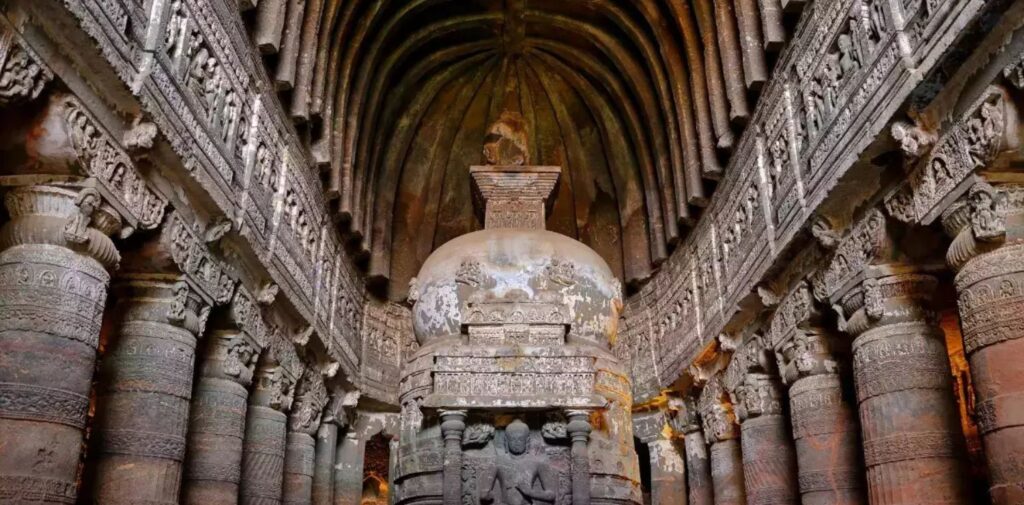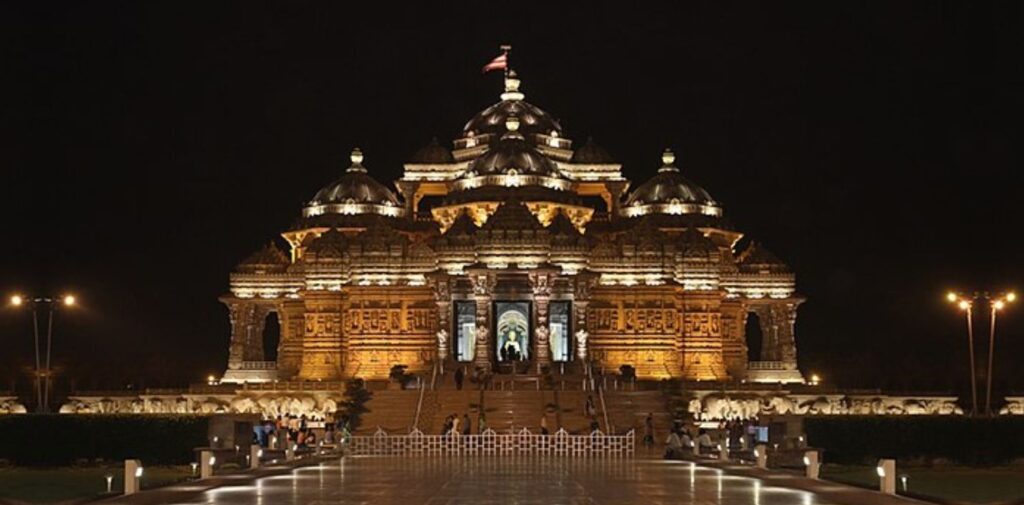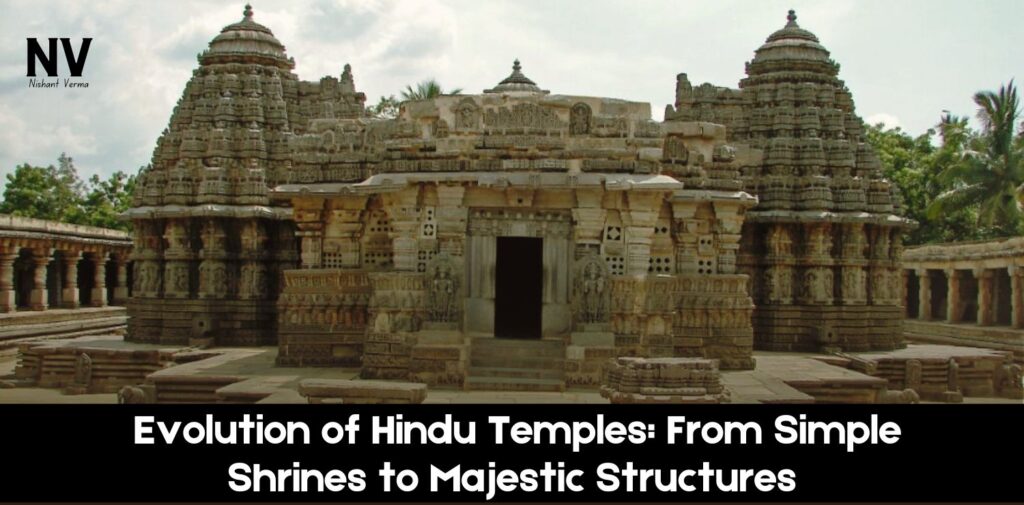Hindu temples have a rich history, and their design and construction have evolved over thousands of years. What began as simple shrines made of natural materials slowly grew into some of the most magnificent and intricate structures in the world. This article takes you on a journey through the development of Hindu temples, from the earliest simple shrines to the grand and complex temples we see today.
Early Beginnings: Simple Shrines and Cave Temples
The roots of Hindu temple architecture go back to the prehistoric and early Vedic periods. Initially, there was no grand concept of a temple in Hinduism. Worship was performed in open spaces, sacred groves, or within homes, and deities were often honored with small altars or simple structures. These structures were primarily meant for individual worship, and there was no centralized location for the community to gather.
In the early stages of Hinduism, temples were simple shrines built in natural surroundings, like under trees or beside rivers, symbolizing a direct connection to nature. The first significant shift came when people started building small stone temples to house images of deities.

Cave Temples (3rd Century BCE to 2nd Century CE)
Around the 3rd century BCE, with the influence of the Mauryan empire and later, the Gupta period, Hindu temples started to take more structured forms. One notable example is the development of cave temples. These were carved directly into the mountains and rocks. The most famous of these early temples are the rock-cut caves found in places like Ajanta, Ellora, and Elephanta. These caves often housed idols, had elaborate frescoes, and were used by monks and worshippers for both meditation and rituals.
The Rise of Stone Temples: The Gupta Period
The Gupta dynasty, around the 4th to 6th centuries CE, is considered the “Golden Age” of Indian history. This era marked the rise of sophisticated art, literature, and architecture, including the construction of stone temples. The use of stone allowed for greater durability and more elaborate designs.
During this period, temples were no longer just simple shrines; they became grand structures designed with specific features and functionality in mind. A prime example of this is the Shikhara style, the upwardly sloping tower that became a hallmark of Hindu temples. These temples were designed not just for the deity’s presence but also as spaces to enhance the spiritual experience for the worshippers.
Architectural Elements of Gupta Temples
- Sanctum (Garbhagriha): The main room where the deity is enshrined.
- Mandapa: The hall in front of the sanctum, used for communal worship.
- Shikhara: The tower-like structure that rose above the sanctum, representing the mountain, which is considered sacred in Hinduism.
The temples during this period were generally smaller but laid the foundation for larger, more intricate temples in later periods.
The Dravidian Style: Majestic Temples of the South
Around the 7th century CE, the architecture of temples in South India began to take a distinct form known as the Dravidian style. This style flourished under the rule of the Chola, Pallava, and Vijayanagara empires. Unlike the more modest temples of the north, these temples were grand and featured towering structures, vast courtyards, and complex carvings.
Key Features of Dravidian Temples
- Gopuram: A monumental tower at the entrance of the temple, often covered with intricate carvings of deities, animals, and stories from Hindu mythology.
- Vimana: The central tower above the sanctum, symbolizing Mount Meru, the center of the universe.
- Prakara: Enclosed walls around the temple complex, creating a sacred space.
- Mandapa: Elaborate halls for worshippers to congregate and perform rituals.
The most iconic example of Dravidian temple architecture is the Brihadeeswarar Temple in Thanjavur, built by Raja Raja Chola I. This temple is a marvel of engineering, with a massive central dome and towering gopurams. Temples during this period became not just places of worship but also centers for art, music, and culture.

The Nagara Style: Majestic Temples of the North
In parallel to the Dravidian style in the south, the northern parts of India saw the rise of the Nagara style of temple architecture. This style is characterized by a curvilinear, beehive-shaped spire (shikhara) over the sanctum and was commonly used in the temples of Rajasthan, Uttar Pradesh, and Madhya Pradesh.
The Nagara style evolved gradually over the centuries and reached its peak during the time of the Rajput kings and later the Mughal empire. Unlike the grand, sprawling Dravidian temples, Nagara temples were often smaller but more detailed in their decoration and design.
Key Features of Nagara Temples
- Shikhara: The spire rising above the sanctum, often with intricate carvings.
- Garbhagriha: The sanctum where the main idol resides, usually in a dark, serene chamber to emphasize the spiritual atmosphere.
- Mandapa: The hall or porch leading into the sanctum, used for congregational worship.
- Plinths: The temple was often raised above the ground on a platform or plinth to create a sense of sacred space.
The Kandariya Mahadev Temple in Khajuraho, famous for its sensual carvings, and the temples of Vrindavan and Mathura are prime examples of this style.
Renaissance of Temple Architecture: Mughal and Maratha Influence
During the Mughal era, there was a significant shift in the development of Hindu temples. While the Mughals themselves were Muslims, the period saw a renaissance in temple architecture due to the efforts of regional rulers and patrons. Some temples were rebuilt or expanded during this time, incorporating both indigenous and Mughal architectural influences.
Influence of Mughal Architecture
Mughal architecture is known for its symmetrical and ornamental style, as seen in the Taj Mahal and other Mughal structures. While Mughal influence on Hindu temples was limited, some temples incorporated features like large domes, minaret-like spires, and intricate inlays that were characteristic of Mughal design.
The Maratha Empire also played a role in the restoration of many temples that had been destroyed or neglected during the Mughal period. These temples often saw a blend of indigenous styles with Mughal influences.
Modern-Day Temples: A Blend of Tradition and Innovation
In recent centuries, Hindu temple architecture has seen the blending of traditional designs with modern materials and construction techniques. Today, temples are being built with the help of advanced technology, while still adhering to traditional Hindu principles of architecture.
Modern temples like the Akshardham Temple in Delhi and the ISKCON temples across the world are examples of this evolution. These temples continue to honor the ancient architectural traditions while integrating contemporary elements like air conditioning, advanced lighting, and spacious interiors.

Global Influence of Hindu Temples
With the spread of Hinduism across the globe, temples are being built in places like the United States, the United Kingdom, and Canada. These temples, while reflecting their cultural heritage, adapt to local environments and needs. The design may vary, but the essential principles remain the same: creating a space for devotion, community gathering, and spiritual growth.
Conclusion: Evolution of Hindu Temples
Hindu temples have evolved tremendously over thousands of years, from humble shrines to awe-inspiring architectural wonders. Each period of history brought new ideas, styles, and innovations, reflecting the changing religious, cultural, and political landscapes of India.
Today, Hindu temples continue to serve as powerful symbols of devotion and cultural heritage. Whether it is the towering gopurams of the south or the intricately carved spires of the north, these structures stand as a testament to the creativity and spiritual richness of Hindu architecture.
From cave temples to modern-day sanctuaries, the evolution of Hindu temples is a fascinating journey through history. As time progresses, these temples continue to evolve, standing as monuments to devotion, art, and the divine.




